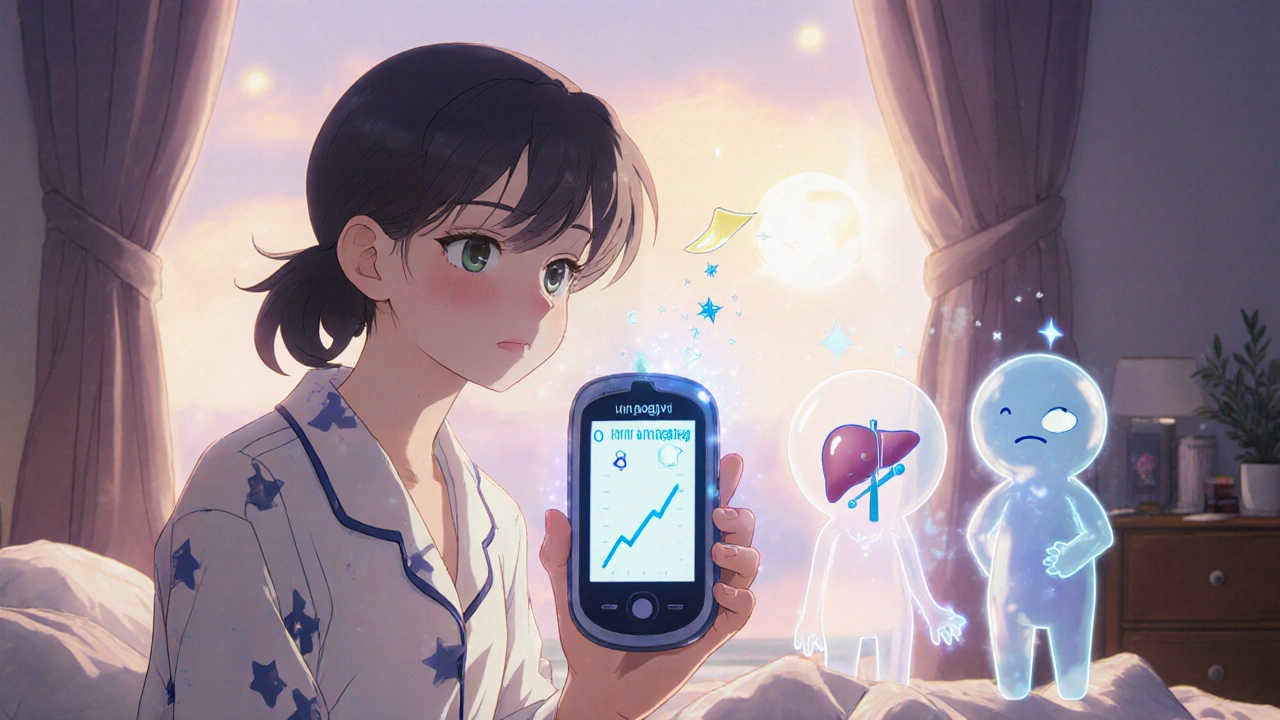
Why Your Blood Sugar Spikes Every Morning
If you wake up with high blood sugar even though you ate well the night before and took your meds, you’re not alone. Around half of all people with Type 1 or Type 2 diabetes experience this every day. It’s not because you ate too much carbs at dinner. It’s not because you forgot your insulin. It’s something called the dawn phenomenon.
This isn’t a mistake. It’s your body doing exactly what it’s supposed to do - just in a way that backfires when you have diabetes. Between 3 a.m. and 8 a.m., your body releases hormones like cortisol, growth hormone, and glucagon. These aren’t bad guys. They’re natural signals that tell your liver to make more glucose so you have energy to wake up and start your day. In someone without diabetes, the pancreas responds by releasing just enough insulin to keep things balanced. But if you have diabetes, your body either doesn’t make enough insulin or can’t use it well. So instead of staying steady, your blood sugar climbs - sometimes from 120 mg/dL at midnight to 200 mg/dL by 7 a.m.
Dawn Phenomenon vs. Somogyi Effect: Don’t Mix Them Up
Many people assume high morning glucose means they went too low during the night and their body overcorrected. That’s called the Somogyi effect. But they’re not the same thing. The Somogyi effect starts with low blood sugar (below 70 mg/dL), then rebounds. The dawn phenomenon? No low at all. Just a steady climb.
How do you tell the difference? Check your blood sugar at 3 a.m. for three nights in a row. If it’s below 70 mg/dL and then shoots up by morning, it’s Somogyi. If it’s already above 100 mg/dL and rising, it’s dawn phenomenon. A 2022 analysis of 10,000 continuous glucose monitor (CGM) datasets found that 68% of morning highs were due to the dawn phenomenon, not rebound.
Getting this wrong can be dangerous. If you think it’s Somogyi and cut your evening insulin, you might end up with dangerously high blood sugar all night. If you think it’s dawn phenomenon and add more insulin without checking, you could crash overnight. That’s why diagnosis matters.
What Happens in Your Body During the Dawn Hours
Here’s what’s actually going on inside you during those early morning hours:
- At around 3 a.m., cortisol levels start rising - up to 50-100% higher than daytime levels.
- Growth hormone secretion jumps 300-500%, signaling your liver to break down stored sugar (glycogen) and make new sugar (gluconeogenesis).
- Your liver ramps up glucose production by 20-30% between 4 a.m. and 8 a.m.
- In non-diabetic people, insulin rises 40-50% to match this surge. In people with diabetes, that insulin response is missing or delayed.
This isn’t broken. It’s normal biology. The problem is that diabetes removes your body’s ability to respond. That’s why your morning glucose can hit 180-250 mg/dL even if your bedtime number was perfect.
Studies show this affects everyone - kids, adults, seniors. One study found 48.7% of children with Type 1 diabetes, 52.3% of adults, and 49.1% of older adults with Type 2 diabetes experience it regularly. It doesn’t care how old you are or how long you’ve had diabetes. It just happens.

How High Morning Sugar Affects Your Long-Term Health
That 200 mg/dL reading in the morning isn’t just annoying - it’s adding up. Every time your blood sugar stays high, your HbA1c creeps up. Persistent dawn phenomenon can raise your HbA1c by 0.5 to 1.2 percentage points. That might sound small, but each 1% increase in HbA1c means a 21% higher risk of nerve damage, kidney disease, eye problems, and heart issues, according to the UK Prospective Diabetes Study.
And it’s not just complications. High morning glucose makes you feel awful. You’re tired, thirsty, need to pee constantly, and your vision is blurry. One survey found 82% of people with dawn phenomenon reported morning fatigue. That’s not just laziness - it’s your body fighting excess sugar.
Severe cases can even lead to diabetic ketoacidosis (DKA). In Type 1 diabetes, uncontrolled dawn phenomenon contributes to 3.2 DKA episodes per 100 patient-years. That’s not rare. It’s a real danger if ignored.
How to Manage It: Practical Steps That Work
Managing the dawn phenomenon isn’t about guessing. It’s about data, timing, and small, smart changes. Here’s what actually helps, backed by research and real-world use.
1. Use a Continuous Glucose Monitor (CGM)
You can’t manage what you can’t see. Finger sticks only give you snapshots. CGMs show the full picture - the slow climb, the speed of the rise, whether it starts at 2 a.m. or 5 a.m. Dexcom G7, Abbott Libre 3, and Medtronic Guardian 4 are all used by endocrinologists for this exact reason. A 2023 survey found 85% of diabetes specialists consider CGM essential for diagnosing and managing dawn phenomenon.
Most CGMs show trend arrows. If you see a steady upward arrow from 3 a.m. to 7 a.m., that’s your dawn phenomenon. You can see it in real time. That’s powerful.
2. Adjust Your Insulin (If You Use It)
If you’re on insulin, especially with a pump or multiple daily injections, you can target the spike directly.
- For pump users: Increase your basal rate by 20-30% between 3 a.m. and 7 a.m. The T1D Exchange Registry found this lowers morning glucose by 45-60 mg/dL on average.
- For automated insulin delivery (AID) systems like Control-IQ: These systems now predict the dawn surge and start adjusting insulin as early as 2 a.m. Clinical trials show a 58-63% reduction in morning highs.
- For Type 2 diabetes on basal insulin: Talk to your doctor about switching from morning to evening dosing. Some long-acting insulins work better when timed to cover the early morning surge.
3. Change What You Eat at Night
What you eat for dinner can make a big difference. A 2021 study from Joslin Diabetes Center showed that reducing evening carbs to under 45 grams lowered morning glucose by 27%. Avoid pasta, rice, bread, or sugary desserts after 7 p.m.
Instead, try a small bedtime snack with protein and healthy fat - no sugar. Think: 1 hard-boiled egg + 1 tablespoon of peanut butter, or 2 tablespoons of cottage cheese with a few almonds. A Reddit survey of over 1,200 people found that those who did this saw 32% fewer morning highs. The protein and fat slow digestion and prevent a sugar spike without triggering insulin.
4. Get Enough Sleep
Poor sleep throws your hormones out of whack. One review in Sleep Medicine Reviews found that people who slept less than 6 hours had morning glucose levels 15-20 mg/dL higher than those who slept 7-8 hours. Stress, screen time before bed, and irregular sleep schedules all make the dawn phenomenon worse. Try to go to bed and wake up at the same time every day - even on weekends.
5. Consider Medication Timing
If you take GLP-1 receptor agonists (like semaglutide or liraglutide), taking them in the evening instead of the morning can help. The DURATION-8 trial showed this lowered morning glucose by 18-22 mg/dL. It’s not a magic fix, but for many, it’s enough to make a difference.
What Doesn’t Work - and Why
Some common advice is misleading. Don’t:
- Just take more insulin at night without checking your 3 a.m. levels. You might crash.
- Ignore your morning highs and blame yourself. This isn’t laziness - it’s physiology.
- Wait for your doctor to bring it up. Most people don’t mention it unless asked. Bring your CGM data to your next appointment.
Dr. John Buse from UNC warned in JAMA Internal Medicine that treating dawn phenomenon without confirming it first often leads to dangerous nighttime lows. That’s why testing at 3 a.m. is non-negotiable.

Real People, Real Results
On diabetes forums, people are sharing what works. One woman in Ohio, Type 1 for 12 years, started using her CGM’s trend arrows and increased her basal rate at 2:30 a.m. Her morning numbers dropped from 210 to 130 within two weeks. Another man with Type 2 switched his GLP-1 shot from morning to night and lost 1.4% off his HbA1c in three months.
But it’s not easy. 57% of people in a 2022 survey said the dawn phenomenon hurt their quality of life. They felt anxious, defeated, or blamed for something they couldn’t control. That’s why understanding it matters. You’re not failing. Your body is just doing what it always does - and now you know how to meet it.
What’s Next for Dawn Phenomenon Management
The science is moving fast. New insulin formulations like Novo Nordisk’s once-weekly icodec are showing 28% better morning control than daily insulins. Researchers at Oxford have found seven genetic variants linked to stronger dawn responses - meaning someday, your DNA might tell you how likely you are to experience it.
Next-gen artificial pancreas systems are already using AI to predict and counteract the dawn surge before it happens. And clinical trials are testing tiny doses of pramlintide - a hormone that blocks glucagon - to shut down the liver’s sugar production during the night.
But for now, the best tools are the ones you already have: CGM, data, and smart adjustments. You don’t need a miracle. You need a plan.
Getting Started: Your 7-Day Action Plan
- Check your blood sugar at 3 a.m. for three nights in a row. Write down the numbers.
- If your 3 a.m. reading is above 100 mg/dL and rising, you’re dealing with dawn phenomenon.
- Look at your CGM trend arrows - when did the rise start? 2 a.m.? 4 a.m.?
- Reduce your dinner carbs to under 45 grams for the next week. Swap rice or pasta for veggies and lean protein.
- Try a small bedtime snack with protein and fat (no sugar).
- Set a consistent bedtime and wake-up time. Aim for 7-8 hours.
- Bring your data to your doctor. Ask: Can we adjust my insulin timing or basal rate? Is my medication timing right?
Success isn’t about hitting zero. It’s about getting your morning glucose below 130 mg/dL at least 70% of the time. That’s the goal. And it’s doable.
Kevin Wagner
November 13, 2025 AT 18:22gent wood
November 14, 2025 AT 03:11Dilip Patel
November 15, 2025 AT 03:01Jane Johnson
November 15, 2025 AT 13:18Sean Hwang
November 16, 2025 AT 14:22Barry Sanders
November 17, 2025 AT 21:25Chris Ashley
November 19, 2025 AT 02:15kshitij pandey
November 19, 2025 AT 20:30Brittany C
November 21, 2025 AT 16:04Sean Evans
November 22, 2025 AT 12:55Anjan Patel
November 23, 2025 AT 01:35Scarlett Walker
November 24, 2025 AT 18:41Hrudananda Rath
November 25, 2025 AT 02:05Brian Bell
November 25, 2025 AT 11:59Kevin Wagner
November 26, 2025 AT 16:23